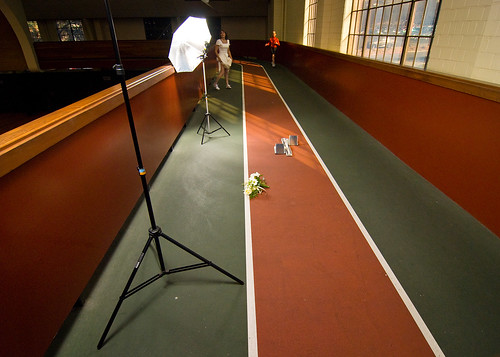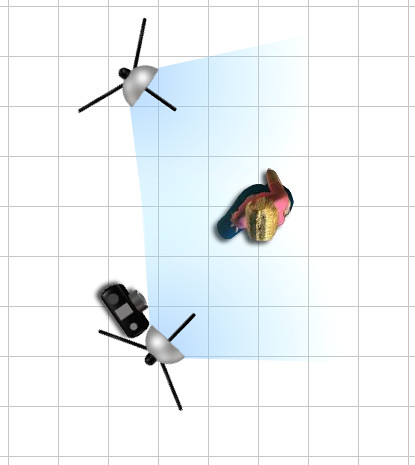Einer Nielson Field House
University of Utah
Salt Lake City, UT
Nikon D200, 1/160s @ f/6.3, ISO 400
Tokina 12-24mm f/4 @ 15mm
Nikon SB-600, camera left at edge of frame
Nikon SB-800, behind and above camera
I recently participated in a local photowalking group's seminar on studio lighting in which I joined other photographers in donating the use of our lighting setups so that other photographers could try new/different lighting styles. I'll write more about this separately but in short there were studio lighting setups in a range of styles from full studio strobes to my Strobist-style use of Nikon Speedlights. Models volunteered their time and about 120 photographers were able to experiment with different lighting and posing techniques using their own cameras.
During the event I didn't have much time to develop long conversations with photographers about using different Strobist techniques and it struck me that I could use my blog to describe how I lit a particular photo and open up the comments to discussion.
I'm kicking off this series with one of my favorite shots, an editorial photo I recently took for the Utah magazine Wasatch Woman under the art direction of Raymond Morales at Katapult Design.
The image was to run with a story on divorce and Ray wanted a shot of a bride captured mid-air at a running track to accompany the Wasatch Woman story on "False Starts."
To give me an idea of what he wanted, Ray showed me some stock images of woman runners caught mid-air, which we used as a foundation for the setup. Of course, Ray could not find a stock photo of a running/leaping bride, which led to this assignment but the stock photos he found were very helpful in conveying to me the image he wanted to create.
After finding just the right location on the track, Ray added a set of starting blocks and a bouquet (with some loose petals dropped around it) to complete the look of a bridal track event.
At the time I was using my Nikon D200 as my main camera (I now use a Nikon D700) and I chose to use a Tokina 12-24mm f/4 wide-angle lens to pull in as much of the track as I could. I opted to go with a front-back lighting setup that would fully illuminate model Alicia McGregor's front and give a bit of highlight and kick to her trailing side to make her pop from the background.
Lighting was created using a Nikon SB-800 on a stand for front/key lighting and a Nikon SB-600 on another stand for rear/fill. Both Speedlights were triggered with the Nikon D200's pop-up flash using the Nikon Creative Lighting System (CLS).
I also wanted to give the track a sense of place and time so I exposed the shot for the window to pull in the Wasatch foothills then I set the Speedlights into remote mode so that I could transmit their power levels via the Nikon D200 and CLS.
I typically fire my Speedlights in manual power mode vs. using TTL, I find that using manual power settings gives me more control and I don't have to fight Nikon CLS and its automatic TTL exposure when I try to go out of bounds (e.g. intentionally firing a Speedlight brighter than a balanced lighting situation).
Once Alicia was in costume (that was her real wedding gown) I initially fired the front SB-800 through a white umbrella placed on Alicia's left side of the track, just in front of her. I was bouncing the light from my SB-600 into a silver reflector just behind her on her right side. This created a big soft light but it was missing something, some pop and contrast.
I moved the SB-800 from Alicia's left-front side over to her right (so that both lights were on the same side), which gave a much more pleasing lightscape but something was still missing, the light just looked too soft, too even.
Here's an example of that setup:
And a shot from above, thanks to www.sdgphoto.com/lightingstudio:
Ray and I went back to the stock photos and then started to brainstorm. He came up with the idea of duplicating the look of bright, harsh daylight and bare camera flashes seen at live sporting events. I removed both umbrellas from the Speedlights, turned them 180 degrees to face Alicia directly and test fired. It was just what Ray was after!
I repositioned the lights to fully illuminate Alicia from the front, to give her a bright highlight from behind and to even catch the edge of my wide-angle lens with a little lens flare and then knelt down just below the SB-800 and angled my camera upwards. Once everything was in place Alicia began the arduous task of running and jumping over the starting blocks while I fired away.
I have to say, Alicia was a real trooper. We shot somewhere between 125-150 frames that day to get just the right moment, which of course meant 125-150 runs and leaps. I heard later that despite being very fit, Alicia was pretty sore the next day. Sorry it took me so long to get that shot, Alicia! :)
Thanks to the model, Alicia McGregor, to Pamela Baumeister, the Editor at Wasatch Woman, to Ray Morales at Katapult Design and to the University at Utah for use of the field house.
Monday, February 23, 2009
How I Lit It: Runaway bride
Labels:
HowILitIt,
wasatchwoman
Subscribe to:
Post Comments (Atom)



7 comments:
Great information!
Did you just call the U. to get permission to shoot, or did you have connections there?
The magazine editor for Wasatch Woman handled arranging for permission. One thing to note was that the running track was not closed during the shoot so we had to work around folks running past and through the set - thanks to them as well for putting up with us!
What a great idea Mike. I love it when photogs share the details of how the shot was made. Thanks for sharing.
Excellent! It's very interesting to see the "behind the scenes" details of how a photo was shot. Thanks for sharing!
That is so cool! I really enjoyed shooting with your set up at the PhotowalkingUT event... up until then I was saving all my pennies for faster glass (which I still am) but now I am going to add some speedlights to the setup -
Thanks again! I look forward to more examples/explanation as well!
Mike this is fantastic - thanks for sharing the knowledge, level of work, and modifications that went into this shot.
That's an awesome explanation. I think it's amazing to watch how photogs use the big lights to set up shots for news stories. We had to do a silhouette portrait once bc the subject was hiding from her husband in a domestic violence shelter and needed to stay anonymous. It took an hour and a half to get it right, but the process was totally fascinating.
Post a Comment